Celebration of QZS-1R test signal transmission with alert flag off
Test signal transmission
Today, on January 31, 2022, the test signal transmission for the start of operation of the quasi-zenith satellite 1 replacement (QZS-1R). The official service of QZS-1R is scheduled to start in late March.
Although it is a test radio wave, the alert flag is off and the health flag is good. We can say the service has actually started. Initially, this signal transmission was scheduled for January 26th, but has been slightly rescheduled.
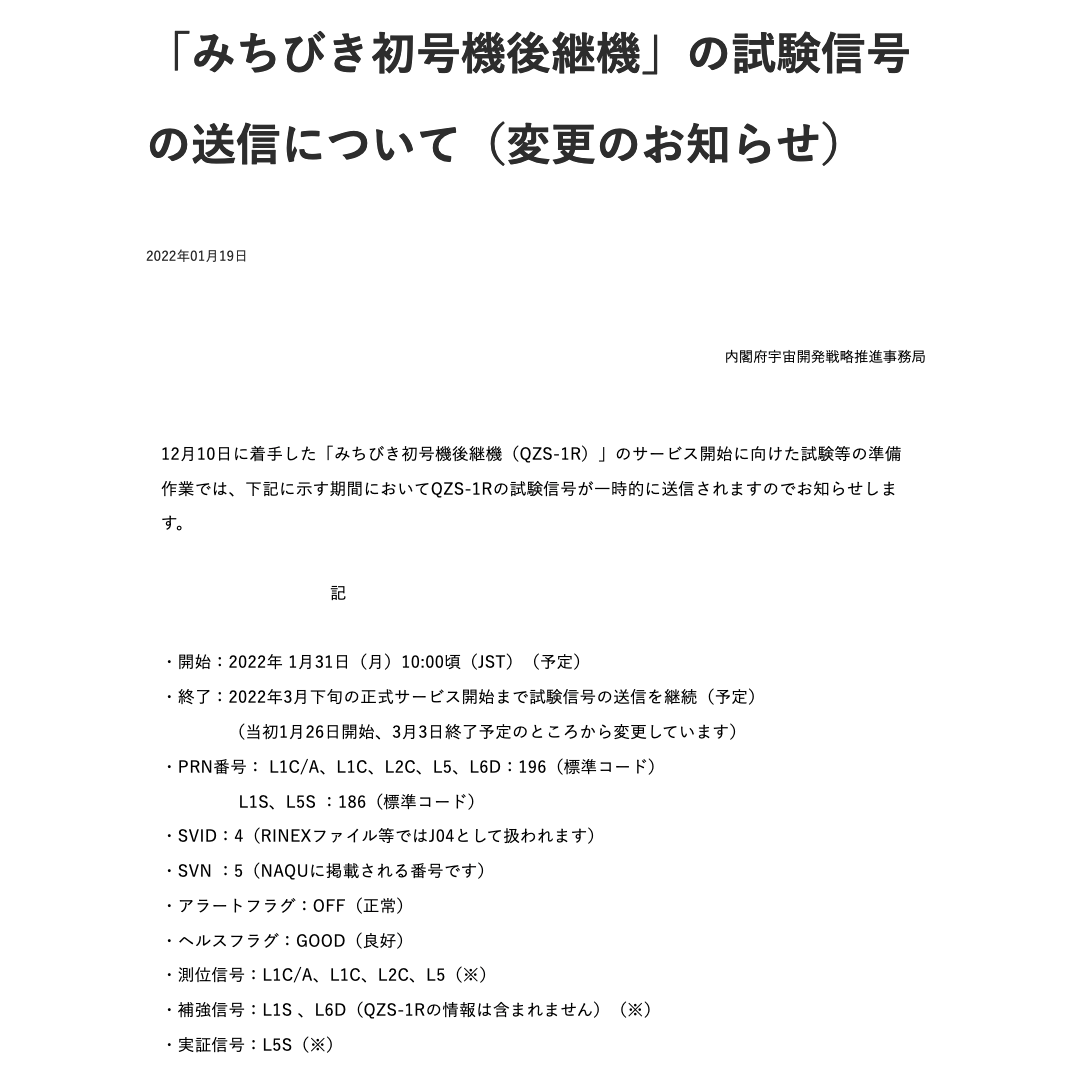
With the alert flag off, both NovAtel OEM729 receiver and HD9310 receiver caught the QZS-1R signal. I am very grateful!
NovAtel OEM729
The QZS-1R PRN (pseudo random noise) number 196, which was not found when the alert flag was on, appears on the receiver monitor screen. I was wrong when I wrote “I was Waiting for new firmware”. The firmware version is 7.08.00. I am very happy. Since the number of channels prepared for OEM729’s QZS signals with this firmware is 4, it is not possible to simultaneously observe the signals of all the 5 QZS constellation at this time. After all, I am looking forward to the new firmware again including L6 signal reception.
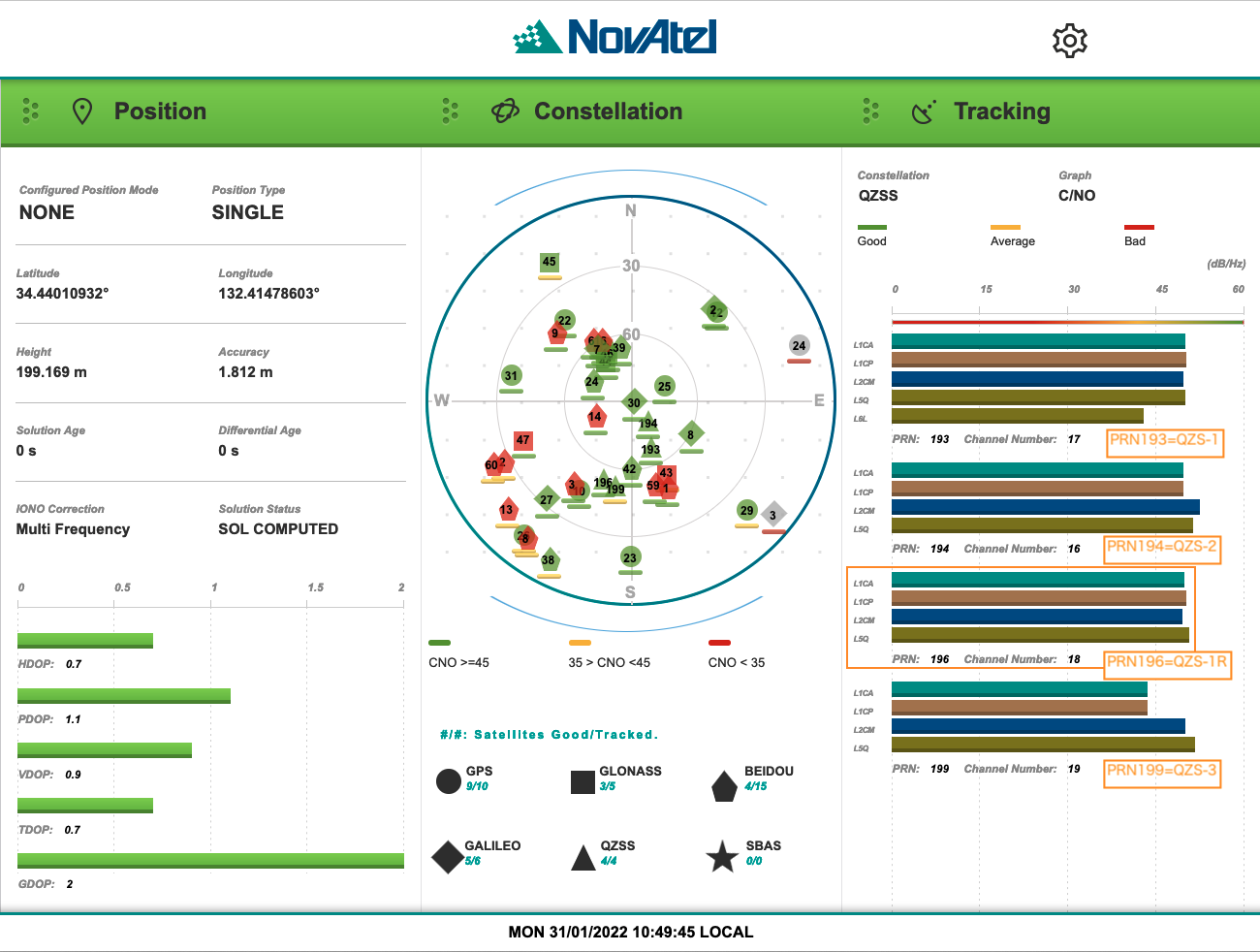
KiwiSDR
The alert flag of QZS-1R is turned off, and its satellite position and ephemeris life are also displayed. Wonderful.
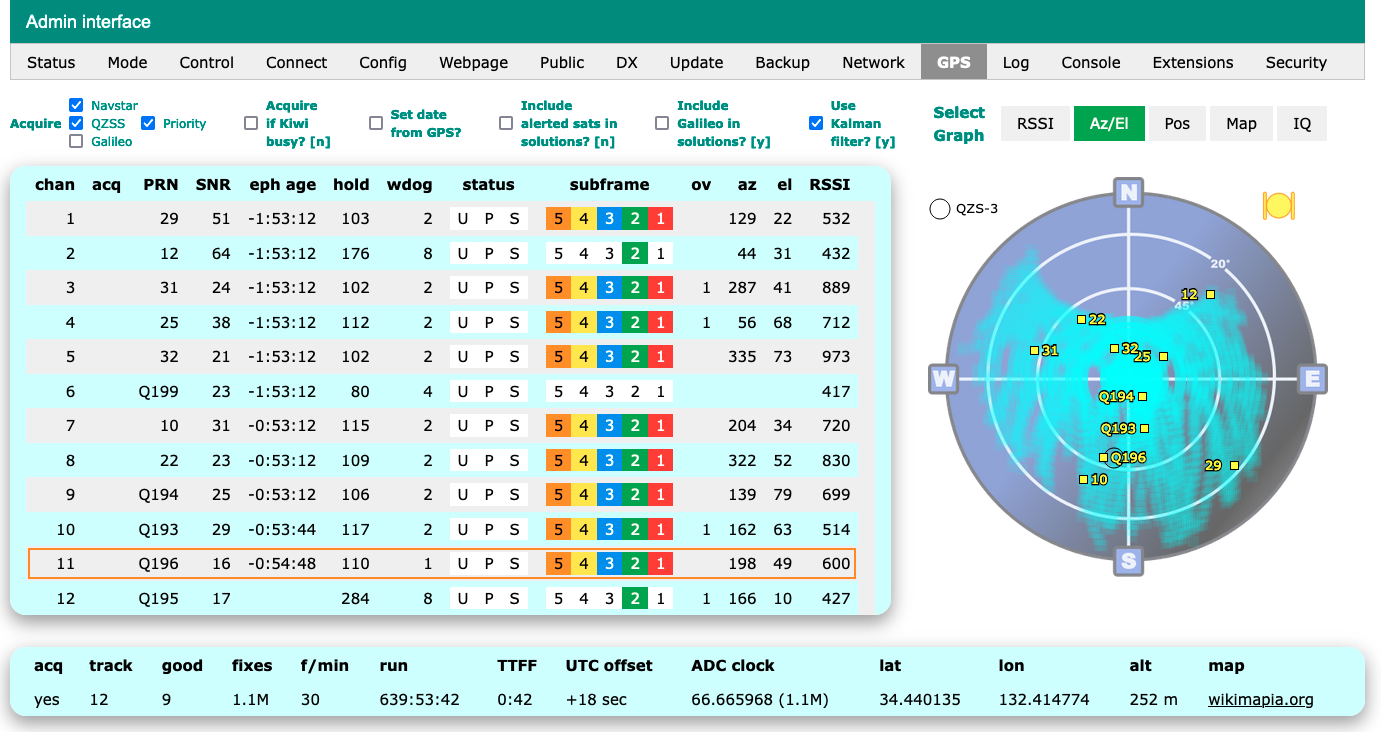
Allystar HD9310 option C
In HD9310, CLAS and MADOCA sent from QZS are exclusively received by the firmware. I have two HD9310s. Therefore, I split the antenna signal with a splitter and supply them, one dedicated to CLAS reception and the other dedicated to MADOCA reception. The firmware version is 3.018bcc6590 for both.
I was able to receive the L1 C/A signal (PRN 196) of the QZS-1R with the CLAS firmware. However, the L6D (CLAS) signal (PRN 196) of QZS-1R is not shown.
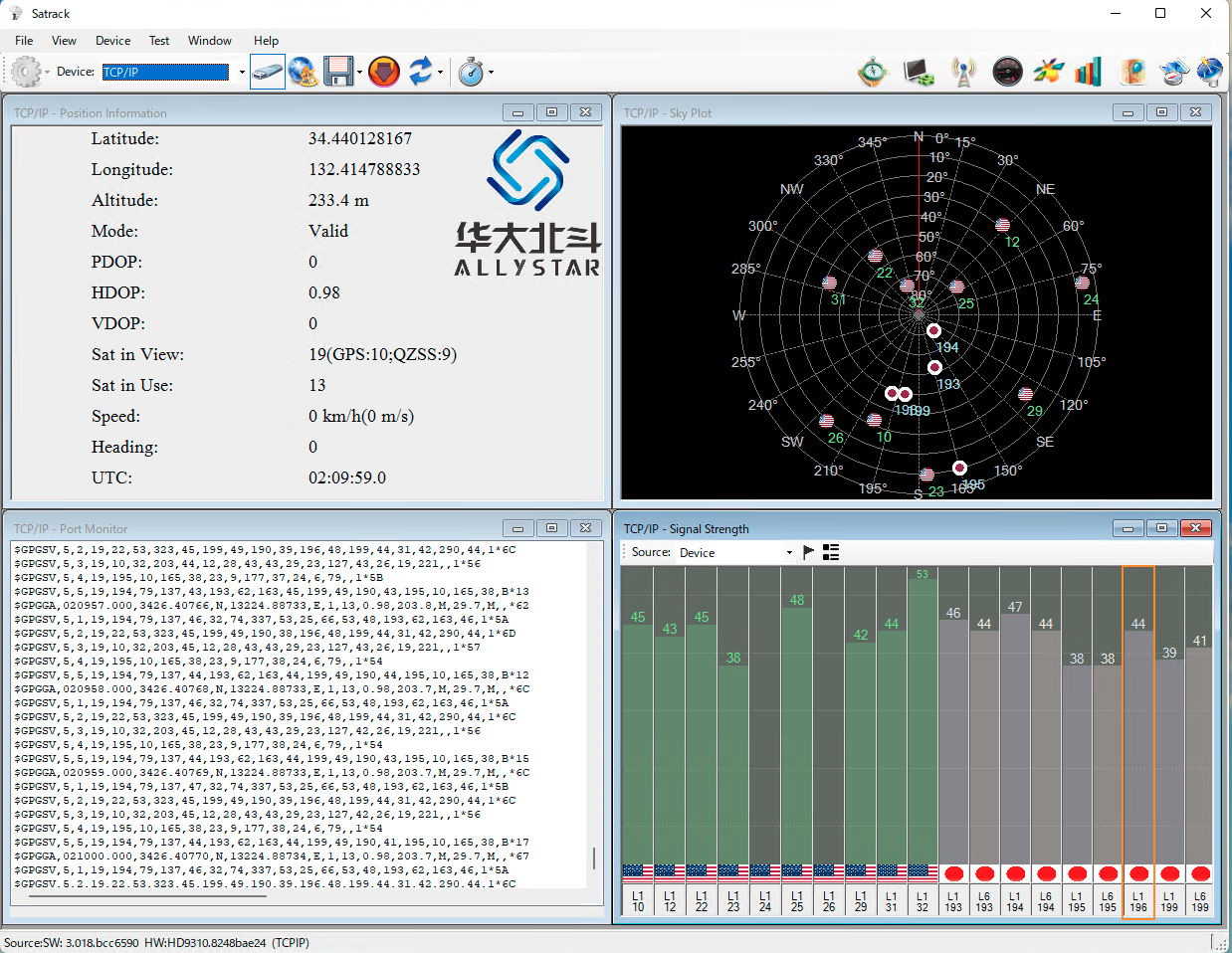
I also checked the raw data output from the HD9310, but there was no L6D signal for the QZS-1R.
195 2195 94409 38
193 2195 94409 43
194 2195 94409 42
199 2195 94409 43
---> prn 193 (snr 43)
The text dumping this raw data represents the PRN number, GPS week number, GPS week elapsed seconds, and the value C/N0 [dB Hz] that is proportional to the signal strength. The line with the arrow shows the PRN number with the highest signal strength at the same time and its C/N0. The L6D signals output at this time are for QZS-1, 2, 3, and 4. After all, the L6D signal of QZS-1R was not found. I will continue to check.
On the other hand, with the MADOCA firmware, both the L1 C/A signal and the L6E (MADOCA) signal (PRN 206) of the QZS-1R could be received. The raw data is also confirmed.
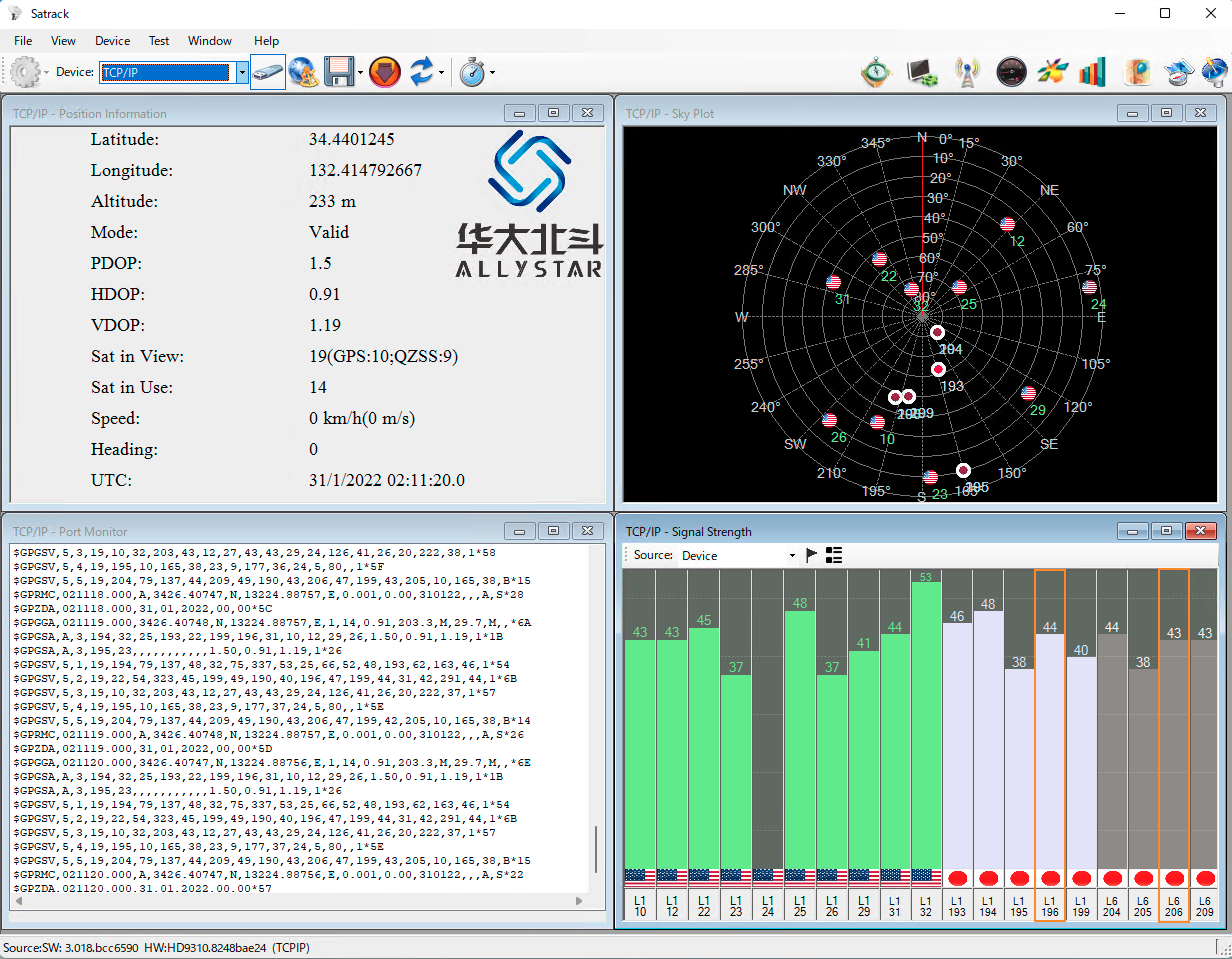
205 2195 94420 38
209 2195 94420 43
206 2195 94420 42
204 2195 94420 43
---> prn 209 (snr 43)
Try fixing the raw data extraction to PRN 206 and deciphering its RTCM message.
RTCM 1062 G SSR hr clock G01 G02 G03 G05 G06 G07 G08 G09 G10 G12 G13 G15 G16 G17 G19 G20 G21 G24 G25 G26 G27 G29 G30 G31 G32 (nsat=25 iod=14)
RTCM 1068 R SSR hr clock R01 R02 R03 R04 R05 R07 R08 R13 R14 R15 R17 R18 R19 R20 R21 R22 (nsat=16 iod=8)
RTCM 1062 G SSR hr clock G01 G02 G03 G05 G06 G07 G08 G09 G10 G12 G13 G15 G16 G17 G19 G20 G21 G24 G25 G26 G27 G29 G30 G31 G32 (nsat=25 iod=14)
RTCM 1068 R SSR hr clock R01 R02 R03 R04 R05 R07 R08 R13 R14 R15 R17 R18 R19 R20 R21 R22 (nsat=16 iod=8)
RTCM 1062 G SSR hr clock G01 G02 G03 G05 G06 G07 G08 G09 G10 G12 G13 G15 G16 G17 G19 G20 G21 G24 G25 G26 G27 G29 G30 G31 G32 (nsat=25 iod=14)
RTCM 1068 R SSR hr clock R01 R02 R03 R04 R05 R07 R08 R13 R14 R15 R17 R18 R19 R20 R21 R22 (nsat=16 iod=8)
There was a valid SSR (space state representation) message. There was no mention of the QZS-1R’s L6E signal on the official page, but it turned out that the QZS-1R broadcasts the L6E signal as well as other quasi-zenith satellites.
Sony Spresense
The C/N0 in Spresense showed 0 dB Hz for the QZS-1R signal with the alert flag on. When the alert flag is off, the correct C/N0 value is shown (Type QCA, ID: 196 column). The firmware version is v.2.4.0. It seems that the QZS-1R signal is also used for positioning. Some of the coordinates are hidden.
2022/01/31 04:20:59.000677, numSat:17, Fix, Lat=34.41xxxx, Lon=132.44xxxx
numSatellites:17
[ 0] Type:GPS, Id: 3, Elv:12, Azm:286, CN0:36.459999
[ 1] Type:GPS, Id: 4, Elv:11, Azm:320, CN0:17.020000
[ 2] Type:GPS, Id:16, Elv:34, Azm:249, CN0:42.770000
[ 3] Type:GPS, Id:18, Elv: 4, Azm:118, CN0:33.809998
[ 4] Type:GPS, Id:22, Elv:60, Azm:176, CN0:45.969997
[ 5] Type:GPS, Id:25, Elv:12, Azm: 54, CN0:32.559998
[ 6] Type:GPS, Id:26, Elv:66, Azm:290, CN0:48.239998
[ 7] Type:GPS, Id:27, Elv: 6, Azm:198, CN0:16.160000
[ 8] Type:GPS, Id:29, Elv:36, Azm: 55, CN0:43.430000
[ 9] Type:GPS, Id:31, Elv:66, Azm: 37, CN0:48.239998
[10] Type:GPS, Id:32, Elv:38, Azm:166, CN0:45.299999
[11] Type:Q1S, Id:184, Elv:81, Azm: 38, CN0:47.989998
[12] Type:QCA, Id:193, Elv:38, Azm:182, CN0:42.639999
[13] Type:QCA, Id:194, Elv:81, Azm: 38, CN0:48.500000
[14] Type:QCA, Id:195, Elv:30, Azm:157, CN0:41.200001
[15] Type:QCA, Id:196, Elv:27, Azm:196, CN0:37.790001
[16] Type:QCA, Id:199, Elv:49, Azm:189, CN0:38.730000
2022/01/31 04:21:00.000670, numSat:17, Fix, Lat=34.41xxxx, Lon=132.44xxxx
2022/01/31 04:21:01.000695, numSat:17, Fix, Lat=34.41xxxx, Lon=132.44xxxx
Septentrio AsteRx SB (Softbank ALES)
Actually, I don’t own a Septentrio AsteRx SB receiver, but I have a contract for Softbank ALES’s centimeter-class positioning service, so I can observe the AsteRx SB receiver output. The dump result of the RTCM delivery is as follows (some part of the coordinates are hidden).
RTCM 1033 Ant/Rcv info 1438 "GPPNULLANTENNA" 0 rcv "SEPT ASTERX SB"
RTCM 1006 Position 34.41xxxxx 132.39xxxxx 18x.xxx
RTCM 1077 G MSM7 G03 G04 G16 G18 G22 G26 G27 G29 G31 G32
RTCM 1087 R MSM7 R01 R07 R08 R09 R10 R19 R20 R21
RTCM 1097 E MSM7 E07 E15 E19 E21 E27 E30
RTCM 1117 J MSM7 J01 J02 J03 J04 J07
RTCM 1127 C MSM7 C01 C02 C03 C04 C06 C07 C09 C10 C11 C12 C14 C16 C24 C25 C33 C34
There is a symbol J04, that stands for QZS-1R, appeared on the analysis display. Wonderful.
Conclusion
With the QZS-1R alert flag off, NovAtel OEM 729 and HD9310 can now use the signal. I appreciate sending this test signal.